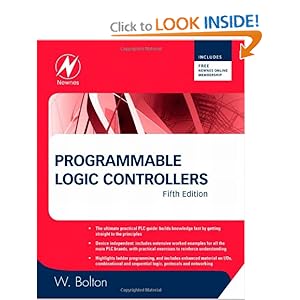Programmable Logic Controllers Fifth Edition
A programmable logic controllers (PLC) is a real-time system optimized for use in severe conditions such as high/low temperatures or an environment with excessive electrical noise. This control technology is designed to have multiple interfaces (I/Os) to connect and control multiple mechatronic devices such as sensors and actuators. Programmable Logic Controllers Fifth Edition, continues to be a straight forward, easy-to-read book that presents the principles of PLCs while not tying itself to one vendor or another. Extensive examples and chapter ending problems utilize several popular PLCs currently on the market highlighting understanding of fundamentals that can be used no matter the specific technology. Ladder programming is highlighted throughout with detailed coverage of design characteristics, development of functional blocks, instruction lists, and structured text. Methods for fault diagnosis, testing and debugging are also discussed. The fifth edition of Programmable Logic Controllers has been enhanced with new material on I/Os, logic, and protocols and networking.
Preface
Prerequisite Knowledge Assumed
Changes from the Fourth Edition
Structure of the Book
Acknowledgments
Chapter 1 Programmable Logic Controllers
Chapter 2 Input/Output Devices
Chapter 3 Digital Systems
Chapter 4 I/O Processing
Chapter 5 Ladder and Functional Block Programming
Chapter 6 IL, SFC, and ST Programming Methods
Chapter 7 Internal Relays
Chapter 8 Jump and Call
Chapter 9 Timers
Chapter 10 Counters
Chapter 11 Shift Registers
Chapter 12 Data Handling
Chapter 13 Designing Systems
Chapter 14 Programs
Appendix: Symbols
Ladder Programs
Function Blocks
Logic Gates
Sequential Function Charts
Instruction List (IEC 1131-3 Symbols)
Structured Text
Answers
Index
See More Details About Programmable Logic Controllers book.
the Author of Programmable Logic Controllers, Fifth Edition
W. Bolton has worked in industry, as well as academia as a senior lecturer in a College of Technology, a member of the Nuffield Advanced Physics team, adviser on British Government Aid project to Brazil on technical education, UNESCO consultant in Argentina and Thailand, Head of Research and Development at the Business and Technician Education Council, now retired. He has written many engineering textbooks including: Mechatronics 4th ed., Engineering Science 5th ed., Higher Engineering Science 2nd ed., Mechanical Science 3rd ed., Instrumentation and Control Systems.


